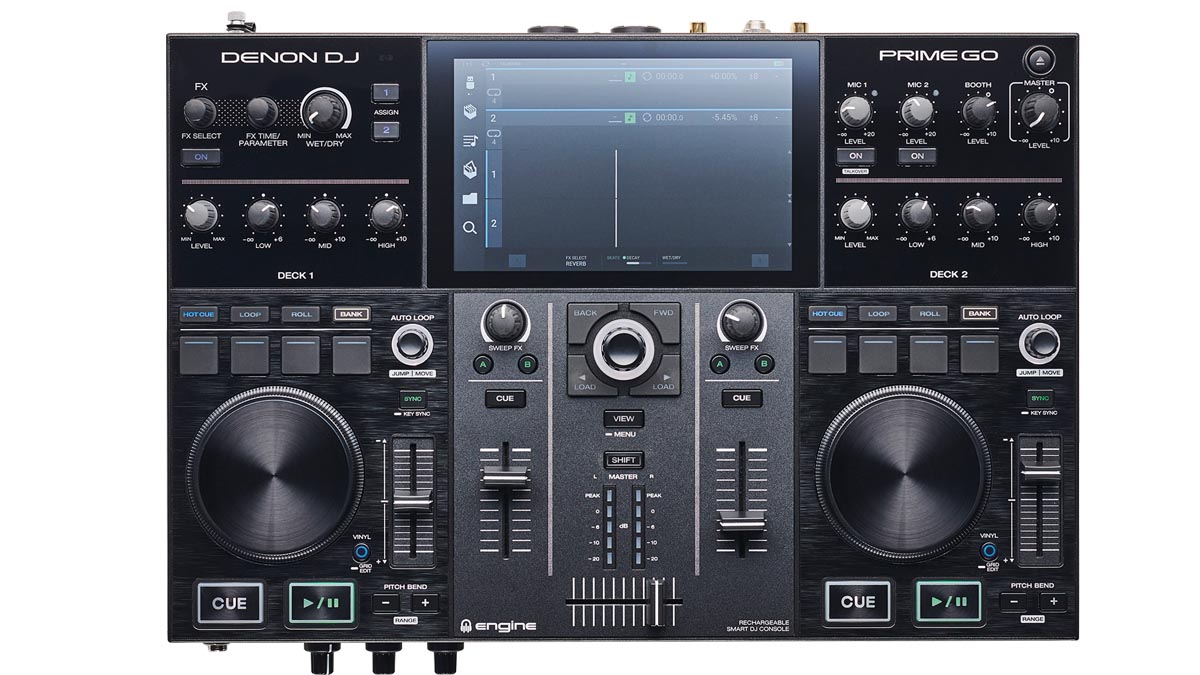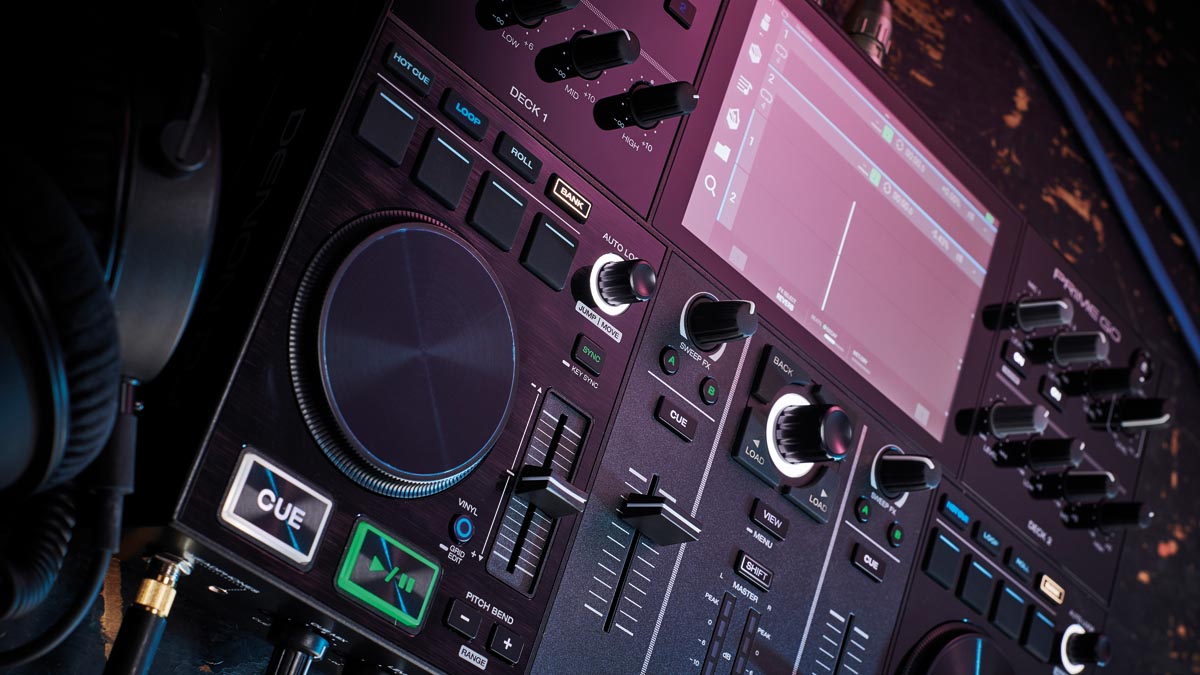MusicRadar Verdict
The Prime Go is well-designed and brilliantly portable, but probably best used as a secondary device to an existing Prime setup.
Pros
- +
Touchscreen is bright, clear and easy to navigate.
- +
Lightweight and truly portable, but with some pro-level I/O.
- +
Mixing tools are simple and effective.
Cons
- -
Too expensive for the entry-level market.
- -
Small jogwheels.
MusicRadar's got your back
What is it?
The past few years have seen Denon put a considerable amount of development into their Prime DJ ecosystem. Prime is focussed around a unified piece of software, but it’s not an app in the vein of Traktor or Serato.
Rather, the Prime range is comprised of multiple players and mixers, all making use of the Engine Prime software that handles track analysis, organisation and the onboard OS for each device.
The Prime Go is the most compact system in the range. It’s an entirely self-contained two-deck DJ setup that boasts true portability thanks to an onboard CPU and rechargeable battery that provides around four hours of wireless use.
The mixing is stripped-back but gets the job done
The hardware itself is roughly equivalent to a Traktor S2 in terms of height and width, although it’s considerably chunkier depth-wise due to that onboard battery.
Despite the extra heft it remains fairly lightweight, and wouldn’t cause you any longterm spine problems if you were to throw it in a rucksack. The feel and build is reminiscent of the Go’s equally-portable InMusic-sibling, Akai’s MPC Live.
While the Go feels a bit more ‘plastic’, the controls feel equally rugged and, like the MPC Live, the Prime Go sports a bright and clear central touchscreen, used here primarily for track browsing.

Performance and verdict
While the Prime Go is the smallest setup in the range, we wouldn’t call it ‘entry-level’; partially due to its price, but also thanks to inclusion of a number of higher level features, including dual headphone ports, separate booth and master outputs and inputs for two mics and one aux source.
Want all the hottest music and gear news, reviews, deals, features and more, direct to your inbox? Sign up here.
On the digital front, there are USB connections for both computer and thumb drive, an SD card slot and ethernet port for use with Denon’s StageLinq system. Prime Go is wifi -equipped too, allowing users to stream directly from Tidal, Beatport Link, Soundcloud and, thanks to the latest update, Dropbox and Beatsource.

• Native Instruments Traktor Kontrol S4
Pretty much a flawless Traktor controller – the only question is: is it for you?
• Pioneer DJ DDJ- SX3
If you’re after a Serato controller for under £1,000 and covers a lot of bases, you can’t really go wrong with the SX3.
The mixing experience itself is stripped-back but gets the job done. Each deck has a fader, gain control, three-band EQ and four pads for looping/hot cues. There’s a single shared effects module, so you can only use one effect at once across the two tracks, but each deck does have a sweep effect rotary, and I like that these can be used for a dub-like delay as well as the standard bi-directional filter sweeps.
The weakest aspects of the Prime Go are its jogwheels, which are very small and pretty basic. That being said, they do have a ‘vinyl’ mode for nudging and scratching and I was pleasantly surprised with how well they handled when beat-matching two unsynced tracks.
For something so portable, the Prime Go is undeniably very effective and a lot of fun to play around with. Its appeal ultimately comes down to how much you want to buy into the Prime ecosystem. For DJs already using a larger Prime setup, it’s a killer device for preparing sets, playing smaller parties and as a backup if something goes wrong.
For something so portable, the Prime Go is undeniably very effective and a lot of fun to play around with
As a first DJ setup, it’s certainly easy-to-use and well-made, although the price probably puts it beyond entry-level and, unless you’re dead set on entering the Prime sphere or really want the wireless power, there are better value options out there.
MusicRadar verdict: The Prime Go is well-designed and brilliantly portable, but probably best used as a secondary device to an existing Prime setup.
The web says
"When it comes to having a fully featured, fully standalone DJ system capable of running without a power source for 3-4 hours – complete with the build quality and inputs and outputs expected from a professional DJ, this really is a unique piece on the market. And it’s all housed in an ultra-portable form factor, while running an OS with the most intuitive UI on the market."
DJ TechTools
"I think mobile DJs looking for a second or backup system are an obvious target audience. Pop this in a flight case and it’ll look completely fine for a main room at a pinch, but certainly it’d be more than enough for a second venue at a wedding – cocktail hour, for instance."
Digital DJ Tips
Hands-on demos
Crossfader
DJKit.Com
Digital DJ Tips
Specifications

- KEY FEATURES: 2-track standalone DJ player/mixer with rechargeable battery, wifi, 2x mics inputs, USB, ethernet, separate master and booth outs and more
- DIMENSIONS: 411mm x 274mm x 53mm
- WEIGHT: 3.68 kg
- CONTACT: Denon
I'm the Managing Editor of Music Technology at MusicRadar and former Editor-in-Chief of Future Music, Computer Music and Electronic Musician. I've been messing around with music tech in various forms for over two decades. I've also spent the last 10 years forgetting how to play guitar. Find me in the chillout room at raves complaining that it's past my bedtime.
